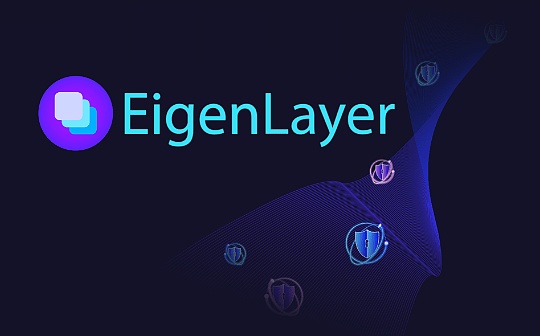
Author: Hamster; Source: Author Blog
Recently, the market has set off a tide of RESTAKING. Many agreements have opened pledges. The TVL of the LRT (liquid restaked token) has also increased significantly, reaching the level of 1.5 billion US dollars.The relationship between LRT and RESTAKING, its advantages and risks, and the LRT protocols that can be involved in the market are all topics worth exploring.
background
RestAKING refers to pledged assets again after initial pledgeEssenceThis strategy is mainly based on the security framework of Ethereum, which aims to improve the efficiency of funds in the entire cryptocurrency ecosystem.Through RESTAKING, pledges can not only support the security of a network, but also provide verification services for multiple networks at the same time, thereby obtaining additional rewards, which is very beneficial to increasing the yield of assets.in short,RestAKING has opened a new way to earn additional benefits for pledges, and at the same time, it has also strengthened the security and stability of multiple networks.
At the same time, a major problem facing Restaking is liquidity.Like POS pledge, after the RESTAKING, the assets “lock” in the node, thereby losing liquidity.To solve this problem, the LIquid RESTAKED Token (LRT) was introduced.LRT is a synthetic tokens issued for RESTAKED ETH, ETHX or other LST.It not only solves the problems mentioned earlier, but also allows Estaking and DEFI to easily access RESTAKING and DEFI.
Compared with LST, LRT is more complicated in technology and economy.For LST, all underlying tokens are pledged only for one task, that is, to ensure the security of the POS chain.However, for LRT, there will be multiple AVS (active verification services). Even if RestAKING is used to ensure safe applications and networks, you need to choose for RESTAKING, which will cause additional additional rewards that allocate a variety of different types.
Therefore, the relationship between LRT and RESTAKING can be summarized as:LRT is a synthetic tokens designed to solve the liquidity problem of asset liquidity in Restaking. It enables the pledged assets to provide security support in multiple services, while bringing additional rewards and returns to pledges.
concept
Liquid pledged tokens (LRT) is a new liquidity of the cryptocurrency market, which aims to improve the capital efficiency of assets.In traditional liquidity mining activities, users deposit their encrypted assets into the liquidity pool to earn rewards, but these assets are usually not further used during pledge.LRT pledge the assets that have been pledged by allowing users to achieve higher capital efficiency and increase the liquidity and flexibility of assets.
Superiority
1. Improve capital efficiency: Through the RESTAKING mechanism,Users can further participate in other pledge projects or borrowing activities without withdrawing the original pledge assetsDo not need to use the native token directly to establish security. ETH, which has been pledged, can ensure the security of Ethereum network and AVS at the same time, thereby improving capital efficiency.
2. Maximize benefits: LRT allows users to obtain multiple benefits from the same assets. Pureists can earn rewards from the verification activities that support multiple services without having to occupy additional funds.This not only improves their capital efficiency, but also increases reward income related to verification servicesEssenceBasic rewards include ETH pledge rewards, AVS re -pledge rewards, and additional LRT usage rewards.
3. Enhanced liquidity: The LRT protocol has re -pledged ETH in various operators through the deposit in various operators, solved the dilemma of liquidity, standardized rewards and risk configurations, and provided users with ETH and tokenization representatives that represented their re -pledges.Allow them to further use these tokens in other DEFI protocols to obtain extra benefits.The introduction of this mechanism helps to increase market liquidity, make the assets more active, and help the prosperity and development of the entire cryptocurrency ecosystem.
risk
1. Increase complexity: RESTAKINGIncreased the complexity that investors need to understand and manage. What needs to be understood is not only the basic pledge and income mechanism, but also how to effectively reinstate assets on multiple networks to obtain maximum benefitsThis is a challenge for novice investors.In addition, the introduction of LRTIt also involves the choice and evaluation of multiple different AVSAnd how to allocate assets between them to obtain the optimized reward structure.
2. Smart contract risk: The realization of LRT depends on the interaction of multi -layer smart contracts,For every layer of smart contracts, new security vulnerabilities or defects may be introduced in theoryThis may cause assets to be stolen or lost.The complexity and interaction of smart contracts make comprehensive audit and verification more difficult, increasing technical risks facing investors.
3. Liquidity risk: Although LRT aims to improve liquidity by providing representative tokens for re -pledged assets, the liquidity of these assets may still be seriously affected under extreme market conditions (such as violent fluctuations or panic).Most LRT protocols are easy to enter.In these cases, the re -pledged assets may be difficult to quickly convert to liquidity, thereby increasing the liquidation risk.
4. Governance risk: Due to the complexity of the LRT protocol in technology and economic level, its governance structure and decision -making process are relatively complicated.This complexity may lead to low governance efficiency, or to enable a small number of interest groups to manipulate the agreement to make decisions to seek private interest, thereby harming the interests of the majority of holders.In addition, due to the need to re -pledge choice for multiple AVS, this further increases the complexity and difficulty of governance, which may lead to the opaque and increase of governance decision -making.
In short,As a financial innovation, LRT also brings higher risk and management complexity while increasing capital efficiency and increasing income potential.Before participating, investors need to carefully evaluate their risk tolerance and investment strategies to ensure full understanding of relevant mechanisms and potential risks.
Project inventory:
>1.eigenlayerTheCircuit Lottery Project, Based on Ethereum, introduced a new primitive in an encrypted economic security-RestAKing.This primitive allows reuse ETH on the consensus layer.Users who use ETH or use LST pledge ETH can choose to join the EIGENLAYER smart contract to re -pledge their ETH or LST and expand the encrypted economy security to other applications on the network to get additional rewards.
2. KELP DAOTheThe multi -chain liquidity pledge platform, Kelp Dao was initiated by the former member of the Stader Labs team. It is currently focusing on building an LRT solution on Eigenlayer.It aims to provide liquidity for non -liquid assets that deposit into the pledged platforms such as Eigenlayer.At present, KELP DAO does not charge any fees for LST deposits.This means that users can currently store ETHX, SFRXETH, and STETH on Kelp Dapp without any costs.
3. Stake FinanceTheIt is the first agreement to launch a modular liquidity pledge on Eigenlayer, which proposes a decentralized yield re -mortgage methodAllows users to obtain Ethereum pledge rewards and Eigenlayer native rewards without locking assets or maintaining pledge infrastructure.Restake Finance will be supported by RESTAKE Finance Dao, which will ensure that the project is loyal to its decentralization and ensure the interests of the stakeholders.The DAO will be managed using RSTK tokens. The core goal is to create value for token holders through governance and income.
4. Renzo ProtocolTheThe first native pledge agreement launched on EIGENLAYER’s main networkEssenceProvides interfaces pledged on Eigenlayer to eliminate technical obstacles, resource allocation and risk management.In turn, you can also create new elements and design considerations for AVS applications, promote open innovation, and flexibly build an open distributed system.
5.Puffer FinanceTheThe first native liquidity pledge protocol on EigenlayerIt makes the native pledge on Eigenlayer easier to access, allowing anyone to run the Ethereum POS verification device while increasing their rewards.The pledgee and node operator jointly create a flywheel effect that makes the growth rate of Puffer exceed the traditional liquid pledge protocol.However, in order to ensure that Puffer will never pose a threat to the credible neutrality of Ethereum, the Burst Threshold sets the upper limit of the Puffer to 22%of the authentication set.
6. Etherfi: Decentralized, non -custody entrusted pledge agreement, with liquidity pledge to derive toburns.One of Ether.fi’s remarkable feature is the pledged controller controlled their private keysEssenceThe Ether.Fi mechanism also allows the creation of a node service market. The pledgee and node operators can register nodes to provide infrastructure services. The income of these services shares with the pledgers and node operators.
7. Swell Network: Non -custody pledge agreement, launched RSWETH. With the help of Swell, users can earn passive income by pledge or re -pledged ETH to get blockchain rewards and re -obtained AVS rewards.Sex (LST or LRT) to hold or participate in a wider Defi ecosystem to earn additional benefits.
8.stakestoneTheThe full -chain LSEssenceWith its highly scalable architecture, Stakestone not only supports the leading pledge pools, but also compatible with the upcoming pledge.At the same time, it establishes a multi -chain liquidity market based on Stone.Stakestone has created the first decentralized migrant pledge solution through an innovative mechanism called OPAP.Unlike the traditional methods that depend on MPC wallets, Stakestone provides completely transparent basic assets and yields.At the same time, OPAP allows optimization of Stone’s basic assets to ensure that Stone holders can automatically and easily obtain optimized pledge returns.
9.babylon: “Eigenlayer of BTC Ecology”Babylon is completely changing our way of expanding Bitcoin, and it does not rely on adding a new layer or building a new ecosystem on Bitcoin.Instead, it extract security from the Bitcoin chain and share it with various POS chains.BABYLON is developing a Bitcoin pledge agreement that allows Bitcoin holders to pledge their BTC on the POS chain and earn pledge (and pledge) their BTC income to ensure the POS chain, application and application chainSafety.Unlike the existing methods, this innovation agreement of Babylon eliminates the need to bridge, packaging, hooking or hosting the pledged Bitcoin.
10.PicassoTheIt aims to introduce the RESTAKING concept to the Solana blockchain. Through Eigenlayer’s liquidity re -pledge method, the pledgers are allowed to repeatedly use their assets to pledge on Solana and other networks to obtain additional benefits.The agreement specially focuses on the use of encrypted economic security to provide additional guarantees for different decentralized applications and services.In this way, Picasso not only increases the liquidity of assets, but also promotes the overall security and stability of the network through sharing security mechanisms.
These projects show the diversity and innovation of the LRT field, and also point out the potential and development direction of the pledge market.When choosing to participate in these projects, it is recommended to study their respective characteristics, risks and potential income in detail to make wise investment decisions.
Summarize
The introduction of LRT marks an innovation leap in the field of encryption asset pledgeBy unlocking the liquidity of the pledged assets, LRT allows these assets to reinterpret in multiple networks and services to obtain additional benefits, which improves capital efficiency and income potential.
However, the same as all innovations,LRT is also accompanied by risks, including increased technological complexity, potential security vulnerabilities of smart contracts, and the impact of market volatility.Before participating, investors need to understand these risks and formulate corresponding risk management strategies to ensure that while pursuing benefits, they can also effectively control potential losses.









